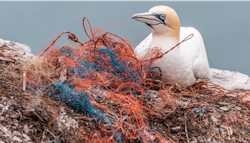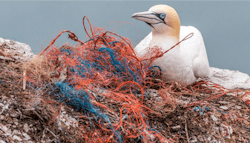Plastic particles and their impact on water
Estimates suggest that at our current rate of disposal, by 2050, on a weight basis, there will be more plastic in the oceans than fish. What treatment technologies are available to help filter out plastic particles?
By Peter Cartwright
Alarming: A recent study found over half of animals sampled had evidence of swallowing plastics
We are constantly exposed to particles in our environment: in the air we breathe, the food we eat and the water we drink.
Particles can be classified as either natural in origin (dirt, slit, dust, microorganisms, etc.) or from “anthropogenic” sources (human made). This article addresses particles generated by human activities.
It is estimated that since the beginning of large-scale production and use in about 1950, more than 7000 million tons (8300 million metric tons) of virgin plastics have been manufactured to date. These include all plastics, but the primary resins are the low and high density polyethylenes. As of 2015, less than 9 percent of plastics are recycled, 12 percent incinerated, and the remaining 79 percent thrown away or landfilled every year. Virtually none of these plastics are biodegradable.
Globally, more than 300 million tons of plastic per year are manufactured and eventually thrown away. Think about it: one million plastic bottles are manufactured every minute throughout the world, and that rate is expected to increase 20 percent by 2021.
particle sizes
Regardless of where they originate (household, toilet, store, manufacturing plant, etc.), plastics are flushed down the sink and toilet, landfilled, incinerated or just carelessly discarded. Those that become part of sewage sludge or a landfill ultimately end up in the soil or in a water body (lake, river, ocean). Note that virtually every lake and river ultimately discharges into an ocean, sea or gulf. Although plastics will not biodegrade, most are readily broken down by ultraviolet radiation from the sun and movement within the oceans.
Quantities
The ubiquitous nature of these particles on and in ocean sediment is underscored by the fact that a recent study found particles in crustaceans dwelling at the bottom of the deepest trenches in the oceans. Between one-half and all of the animals sampled had particles in their guts. These trenches are as deep as 36,000 feet below the surface.
Plastic particles also include synthetic fibers in textile products. Although fibers can enter the environment simply through the wearing of clothes, the greatest contribution to our water supplies is from the action of washing. One study found that acrylic fabrics released 730,000 fibers per wash, five times more that polyester/cotton fabric and 50 percent more than polyester. Furthermore, a comprehensive academic study - Anthropogenic contamination of tap water, beer, and sea salt - examined 159 globally sampled tap waters and found that 81 percent contained plastic fibers greater than 2½ microns in length.
Accurate data on quantities of particles in our water supplies are extremely difficult to obtain; however, there are numerous estimates out there, and one predicts that if our rate of plastics production continues and no mitigation measures are taken, by 2050, on a weight basis, there will be more plastic in the oceans than fish.
mitigation strategies
Obviously, the presence of particles in water means that they are in our drinking water. Treatment plant filtration technologies are incapable of removing particles much below 10µ in size. Although accurate counts are virtually impossible to obtain, a significant percentage of the total volume of plastics in the environment is estimated to be in the Micro- and Nano- size range - less than 10µ.
Whether plastic particles have an effect on human health is unknown at this time, but, intuitively, particularly with the fact that PPCPs are associated with them (and supported by documented effects on aquatic creatures), it’s difficult to believe that a link will not ultimately be identified.
Treatment technologies
Concerning our drinking water, those technologies capable of extremely fine filtration will remove particles. The crossflow, pressure-driven membrane separation technologies of microfiltration, ultrafiltration, nanofiltration and reverse osmosis are all capable of removing particles to one degree or another. The key is particle size. Most microfiltration membranes are effective down to at least 0.1µ; ultrafiltration is capable of removing particles at least in the 0.01µ range, and nanofiltration should be able to remove down to 0.005µ.
Reverse osmosis, the tightest of all, should remove virtually any size particle. Additionally, this technology, combined with activated carbon adsorption, will also significantly reduce the concentration of PPCPs and other dissolved chemicals.
From a regulatory point of view, the USEPA Long Term 1 Enhanced Surface Water Treatment Rule (virtually identical to the WHO requirements) mandates that for drinking water produced by conventional and direct filtration systems, “…samples for turbidity must be less than or equal to 0.3 NTU in at least 95 percent of the samples in any month.”
While there is technically no direct relationship between turbidity and suspended solids (one is light scattering by suspended materials and the other total weight of particles above a certain size), they are both related to the suspended solids content of a water sample. These solids include dirt, dust, sand, colloids, algae, pollen, and all microorganisms such as cryptosporidium and giardia.
A turbidity of 0.3 NTU is roughly equivalent to a TSS level in the range of 0.05 to 0.10 mg/L. For municipal supplies, this rule ensures that the total concentration of particles in our drinking water is probably less than 0.10 mg/L (ppm).
For material changes, there have been a number of biodegradable plastic polymers developed over the years (primarily based on corn starch), but cost and some unethical claims have limited their acceptance by the consumer. Biodegradable plastic bags for kitchen scraps are widely available in Europe now. Plastic straws are virtually always used only once and are so small and light that they are rarely recycled. An edible (and biodegradable) drinking straw made from seaweed is now on the market. Known as “Lolistraw,” this product exemplifies the “out-of-the-box” thinking required to address these issues.
For behavioral changes, humankind must rethink how we look at particle pollution. If we continue to use chemical products based on fossil fuels, we must be aware that they cannot decompose into the basic chemical building blocks of carbon and water. We must embrace recycling as never before.
Most thermoplastics can be recycled, and such plastics as polyethylene terephthalate (drinking and soda bottles) are readily recycled. Consumers must demand deposits on bottle purchases. These provide a strong incentive to take the bottle back to the store where recycling is facilitated. A number of states have mandated this, and it is widely practiced in Europe.
Conclusions
There isn’t much we can do about the huge quantity of plastics now covering this planet. Certainly, efforts can be made to recover and recycle plastics in landfills and gyres. However, our primary activity should concentrate on minimization of disposable and other discarded plastics in the future. Although the manufacturer has the ultimate responsibility for this remediation activity, to ensure success, the initiative must begin with the consumer.
Peter Cartwright is the president of Cartwright Consulting. For more information on the article, email: [email protected].

